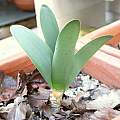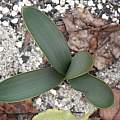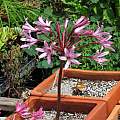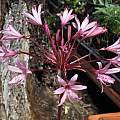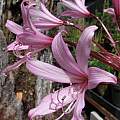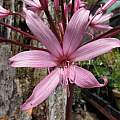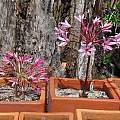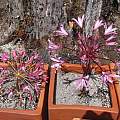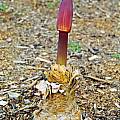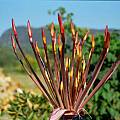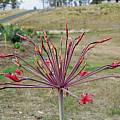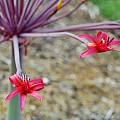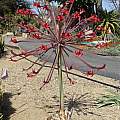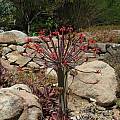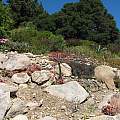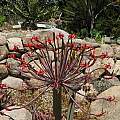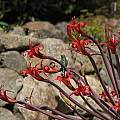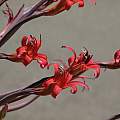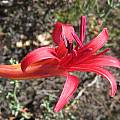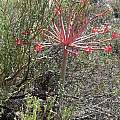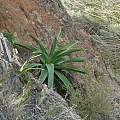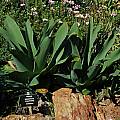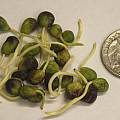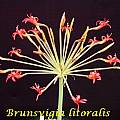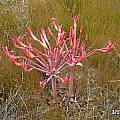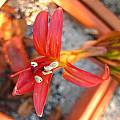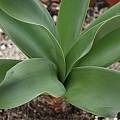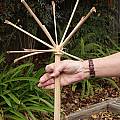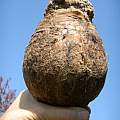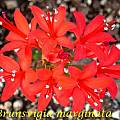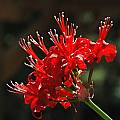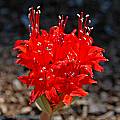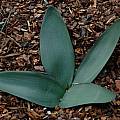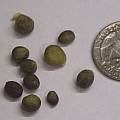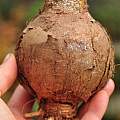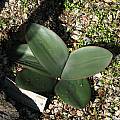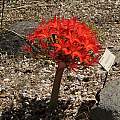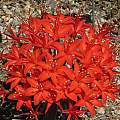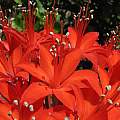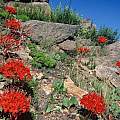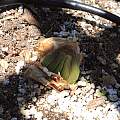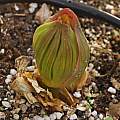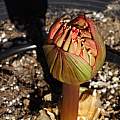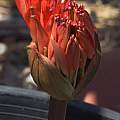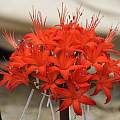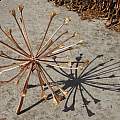Brunsvigia is a South African genus of Amaryllidaceae which grow in semi-arid regions. There are both winter rainfall and summer rainfall species that flower with and without leaves at the time. Some produce amazing floral displays. For more information about this genus see the Brunsvigia main page and index. Species h-m are found on this page.
Brunsvigia species a-g - Brunsvigia species n-z
Brunsvigia herrei Leight. ex W.F.Barker is allied to Brunsvigia bosmaniae. Its distribution range is from Namibia southward into Namaqualand. It grows to 45 cm high with six suberect to spreading, strap-shaped leaves with narrow red margins. It has up to 40 delicate pink flowers on straight pedicels with stamens of two lengths, the outer less than half as long as the inner. It flowers in habitat in March. Photos 1-2 by Uluwehi Knecht show the leaves. Photos 3-6 were taken by Nhu Nguyen, showing various aspects of the flowers and inflorescence.
The photos below by Nhu Nguyen shows a comparison between the two related species, B. bosmaniae and B. herrei.
Brunsvigia josephinae (Redouté) Ker Gawl. (syn. Brunsvigia gydobergensis D.Müll.-Doblies & U.Müll.-Doblies) is a large species which grows up to 65 cm high. It has a widespread distribution in winter rainfall areas from the western Cape to the western Karoo and the Agulhas Plain. It is found or rocky slopes and clay flats in renosterveld. Leaves are 8 to 20, recurved, oblong and smooth. The dark red, orange-yellow towards the base, flowers are in an open, widely spreading head. This species flowers from February to April. Photos 1-4 were taken by Rob Hamilton during February 2003 in Tasmania. The first photo shows an early flower spike which shows the brown and papery tunic of Brunsvigia josephinae. This bulb was replanted late December 2002 and weighed almost 3 kg. Second photos is of a more advance spike which shows yellow on the proximal flower tube. The third photo shows Brunsvigia josephinae in all its glory. Many flowers are yet to open-there are almost 50 in total. The scape is 60 cm (24 inches) wide. The fourth photo is a close-up showing the individual red flowers. Photo 5 was taken by Ron Vanderhoff at the UC Irvine Arboretum October 2009.
The photos below were taken by Nhu Nguyen of specimens at the UC Botanical Garden. Photo #1 shows a full blooming inflorescence among aloes. The second and third shows a hummingbird which acts as a pollinator for this species in northern California.
The first two photos from Cameron McMaster show a plant in habitat in the Eastern Cape. The third photo from Cameron McMaster of the leaves was taken September 2011 near Matjiesfontein. The fourth photo was taken by Mary Sue Ittner at the Karoo Desert NBG. The last photo from Uluwehi Knecht is of seeds germinating next to a U.S. 25 cent piece (2.5 cm wide).
Brunsvigia litoralis R.A.Dyer is a species found in the southeastern Cape in coastal sands. This area has year round rainfall. It grows to 60 cm (2 feet), has about 18 upright twisted leaves and 20 to 40 flowers that are widely spreading and similar in shape and color to Brunsvigia josephinae. It flowers from February to April in habitat. In the northern hemisphere it flowers from August-October. Ken Blackford in southern California was able to grow and bloom this species in a square 1 gallon container. Photo 1 was from Bill Dijk. Photo 2 from Cameron McMaster was taken near Port Elizabeth in the Eastern Cape. Photos 3-5 from Uluwehi Knecht are of a virused plant that was in his collection. Photo 3 is a close up of an individual virused flower. Photo 4 shows leaves and the fifth of a dried infructescence held by a friend for scale. It appears that the virus does not show mosaic patterns on the leaves. Photo 5 of a bulb is by Pontus Wallstén.
Brunsvigia marginata (Jacq.) W.T.Aiton is a winter rainfall species found on rocky mountain slopes, in shale bands in the western Cape. Growing to 20 cm, it has four elliptical leathery leaves pressed to the ground and brilliant red flowers arranged radially symmetrically in a compact head. The pedicels are straight and stamens are tightly clustered in the center and well exserted. This species flowers March to June. The first photo was taken by Bill Dijk and the next three by Mary Sue Ittner including one of the leaves after they have reappeared in fall. Photo 5 from Uluwehi Knecht is of seeds next to a U.S. 25 cent piece (2.5 cm wide). Photo 6 from Pontus Wallstén is of a bulb.
Photos 1-5 below were taken by Nhu Nguyen at the UC Botanical Garden. The first two photos shows a succession of leaf development of a single specimen. The next three shows the plant flowering for the first time. The last photo from Rachel Saunders is of massed bloom of this species near the du Toits kloof pass which had burned a month before.
The photos below show the painfully slow process by which the bud emerges. This specimen is a potted plant growing in California, and blooming for the first time after at least ten years in cultivation (your mileage may vary). On September 3, the bud is barely distinguishable from a leaf. Four days later, the flower stem is just starting to show, and the bud looks a lot like Audrey from Little Shop of Horrors. Three days after that, the stem is elongating and the florets are starting to turn red. After another two days, the flowers are starting to open. The fifth photo shows the flower head as it started to bloom in earnest on September 19. Individual florets continued to open (and older ones wither) for another eight days. The final photo shows the dried seed head in October. It has broken free of the mother bulb and is ready to roll across the countryside dispensing seeds. Photos by Michael Mace.
Brunsvigia index - Brunsvigia species a-g - Brunsvigia species n-z
